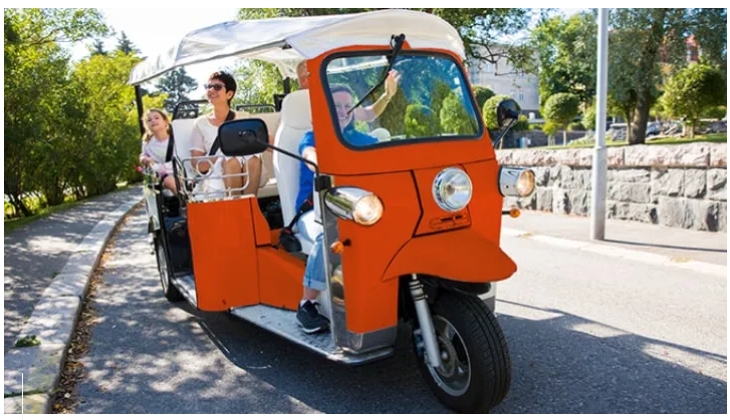In order to meet the growing demand for two-wheelers in the market and accelerate the product launch speed, NXP Semiconductors collaborated with Tessolve, a leading provider of system productization and chip engineering solutions, to enhance the two-wheeler concept validation design introduced by NXP in November last year. The two companies jointly introduced an economically efficient and easy-to-deploy Digital Connected Cockpit (DCC) platform tailored for manufacturers of two-wheelers, three-wheelers, and their tier-one suppliers.
The new generation DCC digital instrument cluster platform has been mass-produced to provide a comprehensive solution for entry-level and mass-market electric vehicles and motorcycles. Additionally, the platform has been optimized for other vehicle types such as scooters and all-terrain vehicles (ATVs) designed for sports, agricultural, and industrial purposes.

### 01
**Digital Transformation in the Mass Market**
The DCC platform combines NXP's rich portfolio of chips and software products, expertise in two-wheeler platforms, and years of experience and excellent customer support in the automotive field with Tessolve's embedded solutions and system integration capabilities to address the challenges posed by the emerging market of electric two-wheelers and three-wheelers. The DCC platform is economically efficient, adopting a scalable design concept to reduce costs, enhance development efficiency, and expedite and simplify the process of acquiring integrated technology. Automakers can choose to directly adopt this platform in their instrument cluster designs "as is" or collaborate with Tessolve to customize software and hardware designs according to their specific automotive requirements.
This DCC platform aims to drive the digital transformation in the mass market, integrating the AW611 Wi-Fi 6 connectivity solution and i.MX RT1170 MCU to offer rich digital instrument cluster graphics and advanced audio connectivity. Additionally, it utilizes NXP's KW45 BLE wireless MCU to provide riders with secure wireless access and location capabilities. Once the KW45 MCU in the two-wheeler's digital instrument cluster is registered in mainstream search applications, riders can track the vehicle's location on a map using a smartphone and trigger sound/light indicators when in close proximity. NXP also provides the multi-channel PF5103 PMIC for power sequencing control and fault management, including power supplies for peripherals.
This reference platform integrates multiple NXP System-on-Chips (SoCs) and other key components on a System-on-Module (SOM) board based on the Standardized Smart Mobility Architecture (SMARC), simplifying the design process for customers. The SOM is mounted on an application board that provides additional system functionalities and connections to displays and other vehicle Electronic Control Units (ECUs). The DCC features a modern compact reference enclosure designed by Tessolve. The digital instrument cluster enclosure is made of ABS plastic and includes a Thin-Film Transistor (TFT) display, LED indicators, a rider-facing camera, rider input buttons, a USB 2.0 port, as well as connectors for power, CAN interface, sensors, and other IOs.
### 02
**Electrification of Two-Wheelers and Three-Wheelers**
From daily commuting to high-end models, two-wheelers are undergoing an electrification revolution. While pedal and gasoline-powered scooters and motorcycles are still prevalent, electric vehicles represent the fastest-growing segment in the two-wheeler market, driven by the convenience of electric vehicles, rising fuel prices, and various initiatives to reduce greenhouse gas emissions. McKinsey reports that although only a small number of two-wheelers are currently electrified, the momentum for electrifying two-wheelers is steadily increasing. McKinsey predicts that in the coming years, the wave of innovation and disruptive change will intensify. The digital display screen of electric two-wheelers will be crucial for industry transformation.
Electric vehicle companies are attracting drivers to switch to electric mobility by developing value-added digital features such as connected instrument clusters. In line with this trend, manufacturers of two-wheelers and three-wheelers are actively integrating digital instrument clusters into their new models. These displays provide real-time data on basic parameters such as speed, RPM, location, navigation, temperature, and range, helping riders focus better and enhancing the overall riding experience.
Connected digital displays with rich graphics are essential for the safe operation of electric vehicles with limited range, providing critical information that allows drivers to view battery levels, charging statistics, detailed navigation information, and charging station locations. NXP's DCC platform aims to enable vehicle manufacturers to offer these basic functionalities while supporting fundamental connectivity use cases that enhance user experience, including hands-free calling, smartphone pairing, music sharing, phone projection, location tracking, secure access, FindMy vehicle location service, Over-The-Air (OTA) updates, fleet management, and more.

